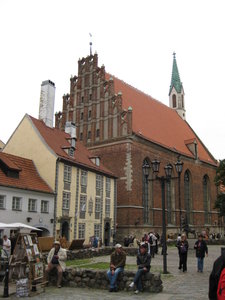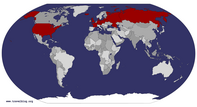Advertisement
Published: September 18th 2010

 My charming hotel
My charming hotel
Located next to two churches (St. Peter's Basilica is out of view to the right)Moving from Minsk to Rīga is jarring. That's no surprise, but it's jarring anyway.
I was relieved when Dmitry's advice turned out to be correct and the Belarusian passport control officer didn't ask for a hotel registration document upon exit. No more visas needed for the rest of the trip - but travel in the EU's Schengen zone means no more fun passport stamps, either.
Didn't love airBaltic's Airport Express shuttle to the city - it's much cheaper than a taxi, and acceptably comfortable, but there's a long wait, it only serves the city's largest hotels, and from those one must walk to one's small B&B on one's own. Might as well use the public bus, at that rate. In any case, I did in time find myself deposited outside the Hotel Riga and the Italian Embassy, not too many blocks from my hotel, but between me and it lay a Ninja Warrior-like obstacle course of cobbles.
Seriously. In the old town, the cobbles are
huge, they're rounded smooth from howevermany years of traffic, and much of the sand in between them has eroded away. This is hell on wheeled luggage (I seriously worried about breaking the wheels,

 St. Peter's Basilica
St. Peter's Basilica
Most of my Old Town photos are from this angle: straight up.the handle, or both, so carried my suitcase about half the way) and it isn't great for walking either. At least it didn't rain - besides all that, wet cobbles are slippery. Grump.
I found my charming hotel on a charming pedestrian square behind Svētā Pētera baznīca (
St. Peter's Basilica), a major landmark. The street in front was lined with souvenir carts, and down the lane I could see restaurants with patios. My "small" room was definitely small, no doubt about that - a big change from my spacious one-bedroom apartment in Minsk! But it was perfectly functional, and I love how the private bath had been cleverly disguised with cupboard-style closet doors to preserve a "historic" look.
I set out to explore the heart of the
Vecrīga (old town), and much as expected, it didn't take much effort. The Rātslaukums (Town Hall Square) opens onto the only Soviet-style building left in central Rīga: the
Museum of Latvian Occupation, which bitterly chronicles Latvia's descent from joyous independence in 1918, to forcible Soviet occupation in 1939 after the signing of the Molotov-Ribbentrop Pact, to Nazi occupation during WWII, and afterward forcible Soviet re-occupation and annexation from the end of the war until independence again

 House of the Blackheads
House of the Blackheads
in which I fancy myself an artsy photographer.in 1991. In other words, all the history that interests me most, packed into one tiny country and one museum.
Back at home, I just finished reading a brief introduction to historiography - the idea that a written history tells you just as much about the time it was
written as the time it describes. The English-language audioguide was worth the low price for the historiographical insights alone - especially the entry where the impeccable British accent says (I'm majorly paraphrasing here):
yes, OK, the Latvians welcomed the Nazis with open arms, yes, the photos of Latvians giving flowers to Nazi soldiers are for real, but can you blame them, after all they had endured under the Soviets, for thinking they were being liberated? I don't think there's anything wrong with saying this - it's an acknowledgment that, out of context, the Latvians' relationship to the Nazis doesn't look good today. Historiography.
Though I've been to many, many cold war museums, at the Rīga museum, I came to understand all sorts of things about Soviet occupation that I hadn't known before.
We already understand that the USSR pursued a policy of cultural totalitarianism as well as the
better-known economic and political kinds. Art, architecture and literature were all controlled by the state and required to uplift Marxist-Leninist ideals, with predictably absurd results (see:
Stalinist architecture,
socialist realism). I also knew that Marxism calls for (expects, actually) workers to reject divisions of race, gender, religion and nationality in favor of a unified proletarian identity. In the USSR, this was enforced through policies of cultural "Sovietization" - especially, attempts to erase nationalistic differences and create a single uniform "Soviet person".
What I didn't know was the extent to which, in practice, "Sovietization" simply meant "Russification". The "Soviet person" had a nationalistic identity, all right - a
Russian one. (Perhaps, since Soviet leaders were overwhelmingly Russian, this seemed "neutral" to them.)
This took some predictable forms: Russian language became mandatory in varying degrees in schools throughout USSR. Nationalistic songs (singing is
very, very important in the Baltics) were banned and "Soviet" songbooks distributed for use at annual Song Festivals instead. Russian political and business leaders were shipped in to run most offices and industries, relegating locals to subordinate roles. As an amateur linguistics geek, I was especially struck to learn that the Soviet authorities issued an order to
permanently remove 
 Museum of Latvian Occupation (formerly Red Riflemen's Museum)
Museum of Latvian Occupation (formerly Red Riflemen's Museum)
Don't know what sorts of inspirational propaganda slogans might have hung here, but here's the frame where they clearly did.a letter (ŗ) from the Latvian alphabet, because it wasn't Russian enough.
Not mentioned in the Rīga museum, but I happened to read last week in a history of Poland, the Soviets did a similar thing in Polish. The Polish language, somewhat uniquely, uses the third person singular as its second person
formal form: think of an olde English butler asking, "would Sir like to have the car brought around?" or "would Madam care for another cup of tea?" In many other languages, including French, Spanish, German and, as it happens, Russian, the second person formal form uses the same word as the second person plural (
vous,
vosotros,
Sie and
вы). So the Soviets attempted to force the entire Polish language to use its second person plural, wy, instead of its third person singular,
Pan and
Pani, for this purpose. It didn't work, but it blows my mind that they would try to control the people at the fundamental level of making the local language's grammar more like Russian!
In that context, the art gallery "Ў" in Minsk is even a bit more interesting - it's named for a letter that only exists in the Belarusian alphabet and,
to me, conveys a bit of Belarusian pride and/or stubbornness against the ongoing dominance of Russian language there.
On a more tangible and less geeky level, I've also learned why shipping people to Siberia, a bit of a joke in the USA (at least among us Gen X and older), isn't funny. Tens of thousands of Baltic families were forcibly deported to Siberia during two major Soviet occupation periods - one before WWII and one in the years following. The lucky ones got a few hours' notice and an opportunity to pack a small ration of belongings to take with them, maybe leave a note for someone. Children were intercepted walking home from school and sent directly to trains. Often, men were sent to Gulag prison camps. Women, small children, infants, and the elderly were packed into cattle cars and rode for days or weeks to remote locales on the steppe or in the Arctic. Unsurprisingly, thousands didn't survive the trip. When they arrived at their new "villages", they might have to build their own shelter and forage for food; plus, the authorities assigned them to work at manual labor such as mining and railroad-building. Back home, no one might know where they went - but the neighbors were free to divvy up the stuff they left behind, or even help themselves to the empty home.
This left room, and available jobs, for the Soviet authorities then to ship thousands of ethnic Russian families
in, continuing the cycle of Russification. (Also, more later on collectivization of farms, which I'd always heard of as a horrifying thing - I finally understand better
why.)
The Rīga museum provides a life-size re-creation of a Gulag barracks, and graphic descriptions by survivors of things like using the sawed-off metal barrel in the corner as a toilet - once a day, which was all they were allowed. Guards might or might not allow them to lay a board across the top to sit on to avoid the sharp edges. In one of the Baltic countries' occupation museums, (they all three have them - comparison and contrast to follow in a later blog post), I forget which one, I was struck by a photo from ca. 1993 of an airport tarmac with row upon row, hundreds of coffins: Balts who had died in Siberian exile, whose families had finally received permission to rebury them in their native soil.
Seeing today how very, very angry the Baltic people are about their treatment under Soviet rule (have you picked up on that? it isn't subtle), I come to suspect that forced "Sovietization" may have been one of the USSR's greater mistakes. That it so often took the form of Russification added insult to injury, but either way, trying to erase national identity and culture only angered the people. It not only strengthened their resolve to resist - it gave them a road map of specific ways to do so. Simply singing traditional songs in secret, whether at home or in the wilds of Siberia, became enough to keep the flame burning for fifty years. When later Soviet leaders eased restrictions, e.g., on singing such songs in public, nationalistic pride burst out and couldn't be contained.
In the end, I feel a bit sheepish that the video footage of independence in 1991, at the foot of the nearby Liberty Monument, with crimson-and-white Latvian flags waving, made me teary-eyed. I'm pretty sure the Museum of Latvian Occupation worked hard to achieve that result, and they surely succeeded.
See all my pictures from Rīga on Flickr:
Rīga 2010 Set
Advertisement
Tot: 0.128s; Tpl: 0.011s; cc: 12; qc: 27; dbt: 0.0621s; 1; m:domysql w:travelblog (10.17.0.13); sld: 1;
; mem: 1.1mb










